AMD Radeon HD 7870 GHz Edition & Radeon HD 7850 Review: Rounding Out Southern Islands
by Ryan Smith on March 5, 2012 12:01 AM ESTOverclocking: Power, Temp, & Noise
As with the rest of Southern Islands, AMD is making sure to promote the overclockability of their cards. And why not? So far we’ve seen every 7700 and 7900 card overclock by at least 12% on stock voltage, indicating there’s a surprising amount of headroom in these cards. The fact that performance has been scaling so well with overclocking only makes overclocking even more enticing. Who doesn’t want free performance?
So how does Pircairn and the 7800 series stack up compared to the 7700 and 7900 series when it comes to overclocking? Quite well actually; it easily lives up to the standards set by AMD’s previous Southern Islands cards.
| Radeon HD 7800 Series Overclocking | ||||
| AMD Radeon HD 7870 | AMD Radeon HD 7850 | |||
| Shipping Core Clock | 1000MHz | 860MHz | ||
| Shipping Memory Clock | 4.8GHz | 4.8GHz | ||
| Shipping Voltage | 1.219v | 1.213v | ||
| Overclock Core Clock | 1150MHz | 1050MHz | ||
| Overclock Memory Clock | 5.4GHz | 5.4GHz | ||
| Overclock Voltage | 1.219v | 1.213v | ||
Overall we were able to push our 7870 from 1000MHz to 1150MHz, representing a sizable 15% core overclock. This is now the 3rd SI card we’ve hit 1125MHz or 1150MHz – the other two being the 7970 and the 7770 – so AMD’s overclocking headroom has been extremely consistent for their upper tier cards.
As for memory overclocking, we hit 5.4GHz on both cards before general performance started to plateau, representing a 12.5% memory overclock. Considering that both cards use the same RAM on the same PCB, and the performance limitation is the memory bus itself, this is consistent with what we would have expected. With that said, we are a bit surprised that we got so far over 5GHz on 2Gb GDDR5 memory chips only rated for 5GHz in the first place; it indicates that Hynix’s GDDR5 production very mature.
With that said, because of the unique and non-retail nature of the 7850 AMD supplied us, the 7850 overclocking results should be considered low-confidence. The retail 7850 cards will be using simpler and no doubt cheaper coolers, PCBs, and VRMs; all of these can reduce the amount of overclocking headroom a card has. It’s by no means impossible that a 7850 could hit 1050MHz/5.4GHz, but it’s far more likely on a 7870 PCB than it is on a 7850 PCB.
Anyhow we’ll take a look at gaming performance in a moment, but in the meantime let’s take a look at what our overclocks do to power, temperature, and noise.
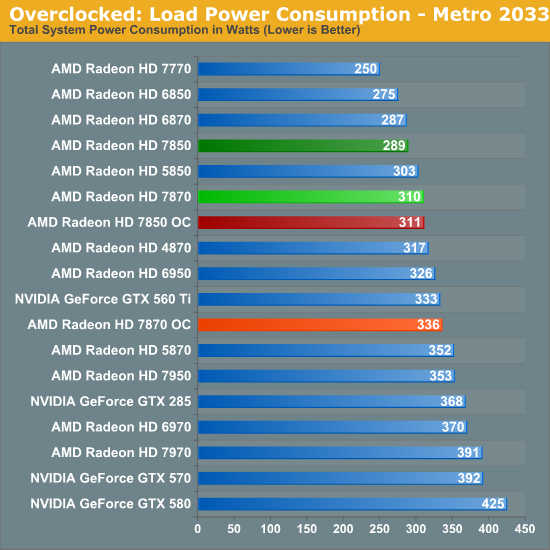
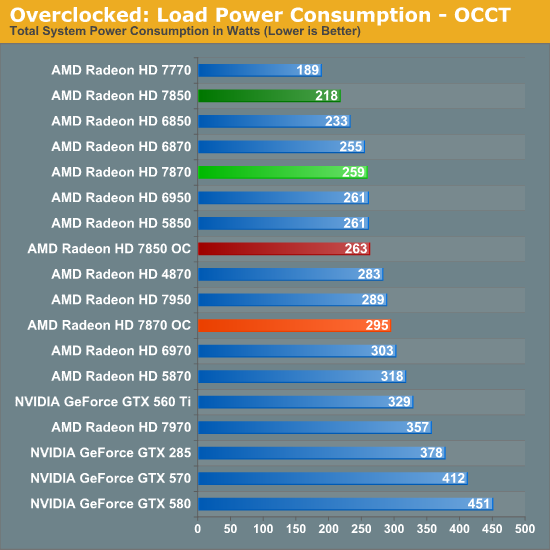
Even without a voltage increase overclocking does cause power consumption to go up, but not by a great deal. Under Metro the total difference is roughly 21W for the 7850 and 25W for the 7870, at least some of which can be traced back to the increased load on the CPU. Whereas on OCCT there’s a difference of nearly 40W on both cards, thanks to the increased PowerTune limits we’re using to avoid any kind of throttling when overclocked. All things considered with our overclocks power consumption for the 7850 approaches that of the 7870 and the 7870 approaches the GTX 560 Ti, which as we’ll see is a fairly small power consumption increase for the performance increase we’re getting.
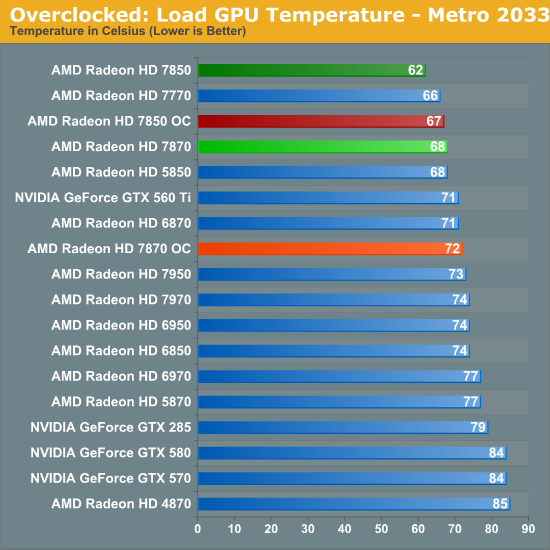
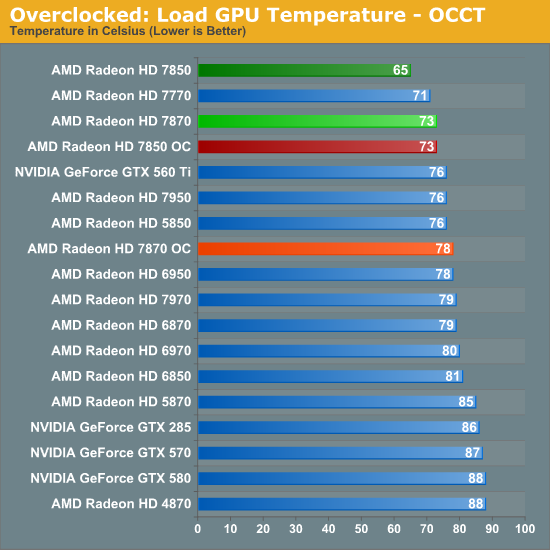
Of course when power consumption goes up so does temperature. For both cards under Metro and for the 7870 under OCCT this amounts to a 5C increase, while the 7850 rises 8C under Metro. However as with our regular temperature readings we would not suggest putting too much consideration into the 7950 numbers since it’s using a non-retail design.
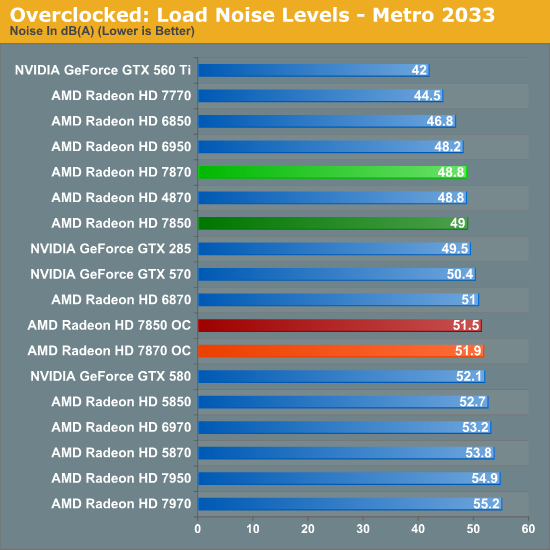
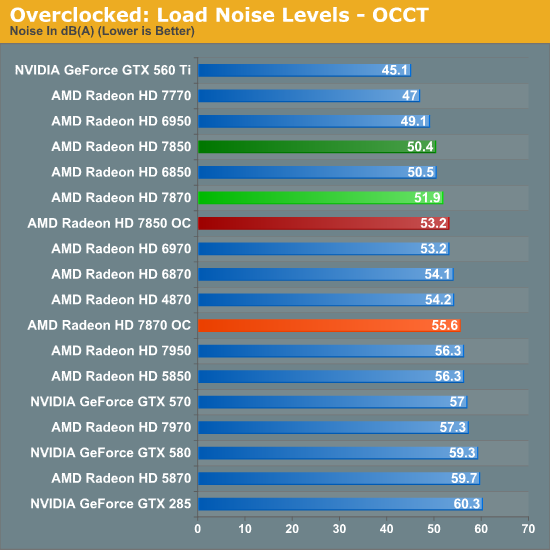
AMD’s conservative fan profiles mean that what are already somewhat loud cards get a bit louder, but in spite of what the earlier power draw differences would imply the increase in noise is rather limited. Paying particular attention to Metro 2033 here, the 7870 is just shy of 3dB louder at 51.9dB, while the 7850 increases by 2.7dB to 51.5dB. OCCT does end up being worse at 2.8dB and 3.7dB louder respectively, but keep in mind this is our pathological case with a much higher PowerTune limit.










173 Comments
View All Comments
Exodite - Tuesday, March 6, 2012 - link
I have absolutely no problem with that.The apt comparison would be the 7900 series though, and those only really fail on price.
Which will likely change if Nvidia brings something competitive to the high end with Kepler.
Lets face it, until the current consoles die in a fire and/or display makers see fit to bring sensibly priced >1080p panels to the desktop there's really no need for more performance in the desktop space.
SlyNine - Monday, March 5, 2012 - link
The fact the things are sitting still.I'm running a 5870 which is basically 75% the performance of a 7970, and I paid 379 for the 5870. Which is also 75% of the cost of a 7970. The price of a 7970 is basically the exact same price structure as the 2 1/2 year old 5870, So we are stuck where we were in 2009, yay.
This is NOT how the computer world is supposed to work, and as big geek, I don't like it.
morfinx - Monday, March 5, 2012 - link
75% performance of 7970 would mean that it's 33% faster than a 5870. And that's just not accurate. I have a 5870 as well, so I was paying a lot of attention on how much faster the 7970 is in various reviews. Everything I've read indicates that it's anywhere from 70-110% faster at 2560x1600 resolution (I run 3600x1920, so likely even even more of a difference). That's not even even considering the massive overclocking headroom of the 7970 vs barely any OC headroom of the 5870. Overclocked, a 7970 is easily twice as fast as a 5870.Alpert - Tuesday, March 6, 2012 - link
The 6950 retailed for $299 and the 6970 retailed for $369 when they were released. 10-25% performance increase for every new series of cards is what to expect. Now we can clearly see these card perform better then the 6950/6970, hell a 7850 overclocks to what a GTX580 is capable of.The value of what was a $600 GTX580 card more then a year ago, The value of a $499 GTX580 today, you get a $300 7850.
The price you pay for performance is always going down just not in big steps.
Logsdonb - Monday, March 5, 2012 - link
These should be excellent cards for crossfire solutions, especially when combined with the new PCI 3.0 bus system. They represent significant improvements in heat, power, and noise at their performance levels. I think these would work well in small form factor gaming PCs, especially when combined with the upcoming Ivy Bridge CPUs, which max out at 77 watts. I don't want a loud, space heater that sucks down massive power for a computer. I have also noticed that cooler systems tend to last longer and have few problems. I feel confident that the prices will come down once the competition from Nvidia comes out next month.I am thinking that we are approaching a really nice time to upgrade if you like balanced systems that deliver excellent gaming performance in reasonable portable packages that wont disturb your personal environment with excess heat and noise. I intend on waiting for Ivy bridge and Kepler before pulling the trigger, but I am eagerly awaiting upgrading evertyhing.
claysm - Monday, March 5, 2012 - link
The price point on the 7xxx series cards seems to be a little too high at the moment, the only advantage they have is that that do outperform the GTX 5xx series cards in a number of ways (power consumption, performance, temps). The biggest problem with the 7xxx series is that they just don't perform that much higher at each price point than AMD's current 6xxx series cards. Why get a 7770 when you can, for the same money and MUCH more performance, get a 6870? The prices will drop when Kepler rolls around I'm sure, but for now, a little too high, given that most of the increases at each price point don't come in the realm of performance.CeriseCogburn - Thursday, March 8, 2012 - link
AMD has been listening to their little screaming fans who wailed that electric usage and core temps are all the rage....So now the amd fans need to PAY UP SOME $$$ for the nice electric consumption and core temp reduction... let's face it - they have told us all for years now those two things alone are well worth a purchase decision, PERIOD.
I guess it's time for them to dig down deep since their Master has responded with everything they declared of utmost importance.
What's wrong AMD fans ?
BrightCandle - Monday, March 5, 2012 - link
I would love to see Anandtech start to look into the stutter/inconsistent frame problems with these modern graphics card reviews. The techreport has been doing a good job in blowing the lid on the problem, but you guys should be able to start to apply pressure to AMD/NVidia to improve the situation. The minimum average is not the worst it can be, the worst frame time is what you need to worry about. Averages over a second just aren't accurate enough.loeakaodas - Monday, March 5, 2012 - link
These look like great performing cards that need a $50~$100 price drop & hopefully nVidia's new offering will force AMD to compete like they did with the legendary 4800 & 5800 series. I was hoping for a sensible upgrade path from my 2x5850's but it doesn't look like that exists yet, at least not at these price points. I'm better off of putting that money towards a large SSD upgrade, otherwise this midrange 2.5 year old system doesn't really beg for an upgrade.ET - Monday, March 5, 2012 - link
The OC 7850 beats everything hands down at the 2560x1600 resolution, which doesn't look right considering the rest of the benchmarks.Also, on the Skyrim benchmark page the writeup has "GPUs GPUs" on it.